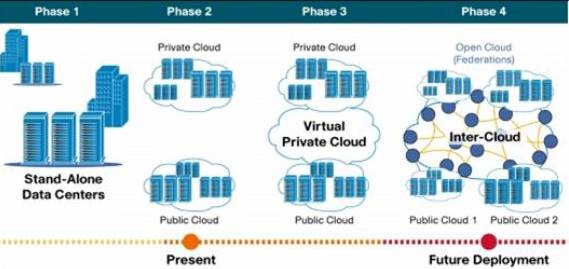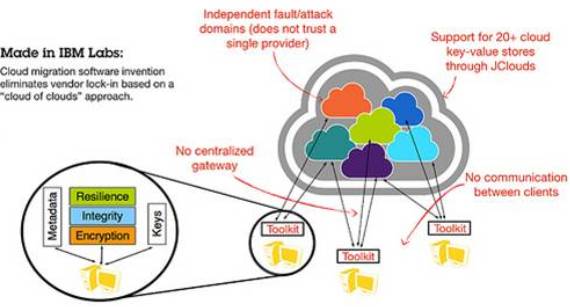Intercloud or ‘cloud of clouds’ is a term refer to a theoretical model for cloud computing services based on the idea of combining many different individual clouds into one seamless mass in terms of on-demand operations. The intercloud would simply make sure that a cloud could use resources beyond its reach, by taking advantage of pre-existing contracts with other cloud providers.
The Intercloud scenario is based on the key concept that each single cloud does not have infinite physical resources or ubiquitous geographic footprint. If a cloud saturates the computational and storage resources of its infrastructure, or is requested to use resources in a geography where it has no footprint, it would still be ableto satisfy such requests for service allocations sent from its clients.

The Intercloud scenario would address such situations where each cloud would use the computational, storage, or any kind of resource (through semantic resource descriptions, and open federation) of the infrastructures of other clouds. This is analogous to the way the Internet works, in that a service provider, to which an endpoint is attached, will access or deliver traffic from/to source/destination addresses outside of its service area by using Internet routing protocols with other service providers with whom it has a pre-arranged exchange or peering relationship. It is also analogous to the way mobile operators implement roaming and inter-carrier interoperability. Such forms of cloud exchange, peering, or roaming may introduce new business opportunities among cloud providers if they manage to go beyond the theoretical framework.
IBM researchers are working on a solution that they claim can seamlessly store and move data across multiple cloud platforms in real time. The firm thinks that the technology will help enterprises with service reliability concerns. On top of this, they hope to “cloud-enable” almost any digital storage product.
Researchers at IBM have developed a “drag-and-drop” toolkit that allows users to move file storage across almost any cloud platform. The company cloud would host identity authentication and encryption technologies as well as other security systems on an external cloud platform (the ‘InterCloud Store’) to keep each cloud autonomous, while also keeping them synced together.

IBM’s Evangelos Eleftheriou explained that the cloud-of-clouds invention can help avoid service outrages due to the fact it can tolerate crashes of any number of clients. It would do this using the independence of multiple clouds linked together to increase overall reliability.
Storage services don’t communicate directly with each other but instead go through the larger cloud for authentication. Data is encrypted as it leaves one station and decrypted before it reaches the next. If one cloud happens to fail, a back-up cloud responds immediately.
The cloud-of-clouds is also intrinsically more secure: “If one provider gets hacked there is little chance they will penetrate other systems at the same time using the same vulnerability.” Alessandro Sorniotti, cloud storage scientist at IBM and one of the researchers, says. “From the client perspective, we will have the most available and secure storage system.”
HP and RedHat have also made offerings of similar kinds, Cisco will invest $1B in the next two years to build its expanded cloud business, and we expect the incremental capabilities to expand the true investment figure even further.
The Future?
Five years from now there will be a suite of international interoperability standards that will lead to a cloud of clouds, or “inter-cloud,” a future where there will be tight integration between multiple clouds. This tighter integration of clouds will have practical implications for businesses, giving analysts the ability to sift through siloes of big data applications to make better informed decisions, according to John Messina, a senior member with the National Institute of Standards and Technology’s cloud computing program. Interoperability is much broader than an organization or consumers talking with cloud providers, but also involves cloud providers communicating with one another and those providers interconnecting with other resources such as social media and sensor networks, Messina said.
NIST along with other international groups such as The Institute of Electrical and Electronics Engineers, the International Electrotechnical Commission, the International Standards Organization and the TM Forum are pushing for interoperability and portability standards. “I think there is a safe prediction that we will have much more interoperability in the future right around the three- to five-year point. Probably closer to five, we will have that cloud of cloud people are talking about,” Messina said.
Randy Garrett, program manager with the Defense Advanced Research Projects Agency’s Information Innovation Office, who also was on the panel, said, “We will see a growth in the Internet of Things,” referring to devices ranging from smart phones to automated sensors and non-computing devices connected to the Internet.
An interconnected world has potential benefits, but it also creates new risks. For example, 10 years ago there was no danger that somebody could remotely take over your car with a cyberattack. But a car today with onboard computers, a GPS receiver and wireless connections is vulnerable. Someone can take over a car. They cannot steer it (unless we are talking about Google’s driverless car), Garrett noted, but can do other things. “So when you take that possibility and spread it out, it makes you wonder what type of future world we will have if somebody can come in remotely change your heating or air conditioning or shut down your car”
Still, a lot of future benefits will arise as a result of connected devices and access to more information such as the better tracking of the rise and spread of epidemics, a larger sampling of medicines or the ability to detect manufacturing defects, Garrett said.
Ahmed Banafa, Author the Books:
Secure and Smart Internet of Things (IoT) Using Blockchain and AI
Blockchain Technology and Applications
References:
IBM launches “cloud of clouds” offering, aims to stop vendor lock-in
http://www.themetisfiles.com/wp-content/uploads/2013/05/Segmenting-The-InterCloud.png
http://blogs.cisco.com/wp-content/uploads/Cloudservices-550×337.png
https://images.computerwoche.de/images/computerwoche/bdb/1872947/522×294.jpg
Comments on this publication